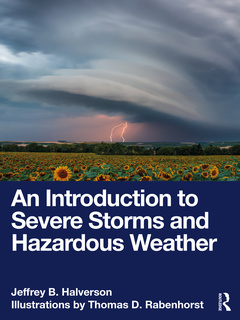An Introduction to Severe Storms and Hazardous Weather
Auteur : Halverson Jeffrey B.

This book presents a deep and encompassing survey of severe weather in all its forms. An Introduction to Severe Storms and Hazardous Weather is an exciting new textbook that allows students to learn the principles of atmospheric science through the drama, exhilaration, and even tragedy of severe weather.
Balancing breadth and depth, Jeffrey B. Halverson adeptly combines a short, accessible introduction to the basic principles of meteorology with detailed coverage on large- and small-scale weather hazards. He draws on specific up-to-date case studies from North America to illustrate the cause of meteorological events including hurricanes, heavy snow and ice, floods, and tornadoes. Unlike existing books on the market, Halverson delves deep into the societal impacts of these events, drawing on examples from agriculture, utility infrastructure, and commercial aviation. Each chapter also features high-quality, customized color artwork by Thomas D. Rabenhorst that helps to enhance and embed learning.
Thorough in its scope, and written with an impeccable focus on the science, this book will be an essential resource for introductory undergraduate courses in severe weather, natural hazards, and extreme meteorology. It is also an excellent supplemental textbook for courses on meteorology and atmospheric science.
A. Introductory Principles
1. An Introduction to Severe Storms & Societal Impacts
2. Meteorological Primer, Part I: Pressure and Wind Relationships
3. Meteorological Primer, Part II: Moisture and Precipitation in Storms
4. Meteorological Observations and Forecasting
B. Weather Hazards Generated by Large-Scale Atmospheric Vortices
5. Structure, Energetics and Climatology of Extratropical Cyclones vs. Hurricanes
6. Genesis, Evolution and Intensification of Extratropical Cyclones and Hurricanes
7. Winter Weather Hazards: Arctic Air Outbreaks, Nor’easters, Blizzards, Lake Effect Snow and Ice Storms
8. Landfalling Hurricanes: Coastal and Inland Devastation
C. Severe Local Storms and Their Weather Hazards
9. Structure and Evolution of Ordinary Thunderstorms
10. Severe Thunderstorms, Emphasizing Supercells and Damaging Hail
11. Tornadoes: Structure, Evolution, and Genesis
12. Tornado Outbreaks, Detection, Warning and Societal Response
13. Violent Thunderstorm Downdrafts: Downbursts and Derechos
14. The Science of Flash Floods
D. Appendix – Heat Waves
Jeffrey B. Halverson received his PhD in Environmental Science at the University of Virginia in 1994, then assumed a post-doc under Dr. Joanne Simpson (the first woman in the United States to receive a PhD in Meteorology) at NASA’s Goddard Space Flight Center. He is currently Professor at the University of Maryland, Baltimore County (UMBC), where he teaches courses on physical geography, water science, natural hazards, meteorology, severe storms, climate change, and Earth’s natural history. He and his team of graduate students investigate severe storms, particularly hurricanes. In 2000 he helped pioneer a new type of technology for measuring air temperature at high altitudes in the eye of hurricanes. Halverson has authored or coauthored more than 60 scientific publications on severe storms and has appeared in science documentaries aired by NOVA, National Geographic, The Weather Channel, and The Discovery Channel. He is a columnist, feature writer, and assistant editor for Weatherwise Magazine. He is a writer and Severe Weather Expert for the Washington Post’s Capital Weather Gang. In 2015 he adapted a new teaching technology – a large, digitally projected sphere of the Earth, called Magic Planet – for teaching his courses.
Date de parution : 06-2024
21x28 cm
Date de parution : 05-2024
21x28 cm
Thèmes d’An Introduction to Severe Storms and Hazardous Weather :
Mots-clés :
severe storm; severe weather; tornado; hurricane; meteorology; atmostphere; blizzards; floods; natural disasters; natural hazards



